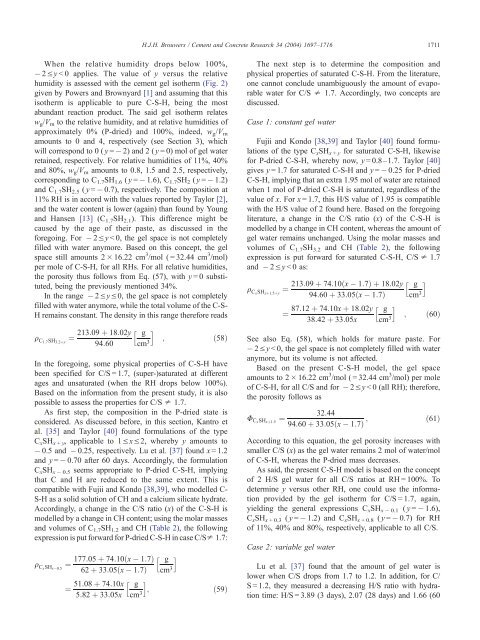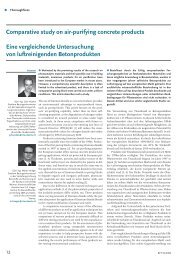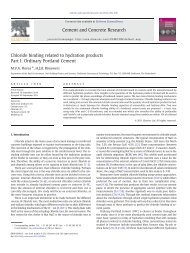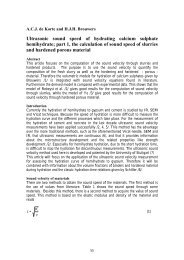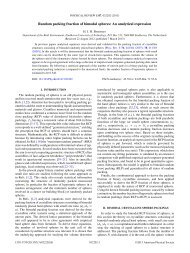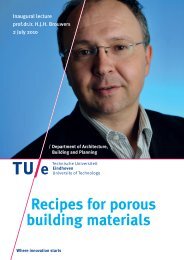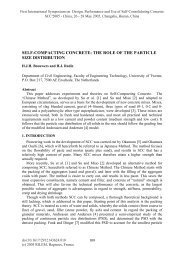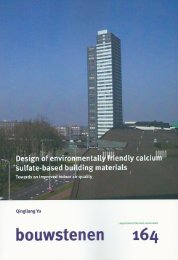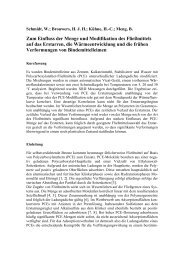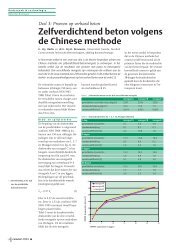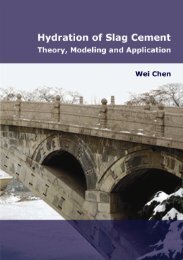The work of Powers and Brownyard revisited: Part 1 - Jos Brouwers
The work of Powers and Brownyard revisited: Part 1 - Jos Brouwers
The work of Powers and Brownyard revisited: Part 1 - Jos Brouwers
Create successful ePaper yourself
Turn your PDF publications into a flip-book with our unique Google optimized e-Paper software.
H.J.H. <strong>Brouwers</strong> / Cement <strong>and</strong> Concrete Research 34 (2004) 1697–1716 1711When the relative humidity drops below 100%,2 V y < 0 applies. <strong>The</strong> value <strong>of</strong> y versus the relativehumidity is assessed with the cement gel isotherm (Fig. 2)given by <strong>Powers</strong> <strong>and</strong> <strong>Brownyard</strong> [1] <strong>and</strong> assuming that thisisotherm is applicable to pure C-S-H, being the mostabundant reaction product. <strong>The</strong> said gel isotherm relatesw g /V m to the relative humidity, <strong>and</strong> at relative humidities <strong>of</strong>approximately 0% (P-dried) <strong>and</strong> 100%, indeed, w g /V mamounts to 0 <strong>and</strong> 4, respectively (see Section 3), whichwill correspond to 0 ( y = 2) <strong>and</strong> 2 ( y = 0) mol <strong>of</strong> gel waterretained, respectively. For relative humidities <strong>of</strong> 11%, 40%<strong>and</strong> 80%, w g /V m amounts to 0.8, 1.5 <strong>and</strong> 2.5, respectively,corresponding to C 1.7 SH 1.6 ( y = 1.6), C 1.7 SH 2 ( y = 1.2)<strong>and</strong> C 1.7 SH 2.5 ( y = 0.7), respectively. <strong>The</strong> composition at11% RH is in accord with the values reported by Taylor [2],<strong>and</strong> the water content is lower (again) than found by Young<strong>and</strong> Hansen [13] (C 1.7 SH 2.1 ). This difference might becaused by the age <strong>of</strong> their paste, as discussed in theforegoing. For 2 V y < 0, the gel space is not completelyfilled with water anymore. Based on this concept, the gelspace still amounts 2 16.22 cm 3 /mol ( = 32.44 cm 3 /mol)per mole <strong>of</strong> C-S-H, for all RHs. For all relative humidities,the porosity thus follows from Eq. (57), with y = 0 substituted,being the previously mentioned 34%.In the range 2 V y V 0, the gel space is not completelyfilled with water anymore, while the total volume <strong>of</strong> the C-S-H remains constant. <strong>The</strong> density in this range therefore readsq C1:7 SH 3:2þy¼213:09 þ 18:02y94:60hgicm 3; ð58ÞIn the foregoing, some physical properties <strong>of</strong> C-S-H havebeen specified for C/S = 1.7, (super-)saturated at differentages <strong>and</strong> unsaturated (when the RH drops below 100%).Based on the information from the present study, it is alsopossible to assess the properties for C/S p 1.7.As first step, the composition in the P-dried state isconsidered. As discussed before, in this section, Kantro etal. [35] <strong>and</strong> Taylor [40] found formulations <strong>of</strong> the typeC x SH x + y , applicable to 1 V x V 2, whereby y amounts to0.5 <strong>and</strong> 0.25, respectively. Lu et al. [37] found x = 1.2<strong>and</strong> y = 0.70 after 60 days. Accordingly, the formulationC x SH x 0.5 seems appropriate to P-dried C-S-H, implyingthat C <strong>and</strong> H are reduced to the same extent. This iscompatible with Fujii <strong>and</strong> Kondo [38,39], who modelled C-S-H as a solid solution <strong>of</strong> CH <strong>and</strong> a calcium silicate hydrate.Accordingly, a change in the C/S ratio (x) <strong>of</strong> the C-S-H ismodelled by a change in CH content; using the molar masses<strong>and</strong> volumes <strong>of</strong> C 1.7 SH 1.2 <strong>and</strong> CH (Table 2), the followingexpression is put forward for P-dried C-S-H in case C/S p 1.7:177:05 þ 74:10ðx 1:7Þhgiq Cx SH x 0:5¼62 þ 33:05ðx 1:7Þ cm 351:08 þ 74:10xhgi¼5:82 þ 33:05x cm 3 ; ð59Þ<strong>The</strong> next step is to determine the composition <strong>and</strong>physical properties <strong>of</strong> saturated C-S-H. From the literature,one cannot conclude unambiguously the amount <strong>of</strong> evaporablewater for C/S p 1.7. Accordingly, two concepts arediscussed.Case 1: constant gel waterFujii <strong>and</strong> Kondo [38,39] <strong>and</strong> Taylor [40] found formulations<strong>of</strong> the type C x SH x + y for saturated C-S-H, likewisefor P-dried C-S-H, whereby now, y = 0.8–1.7. Taylor [40]gives y = 1.7 for saturated C-S-H <strong>and</strong> y = 0.25 for P-driedC-S-H, implying that an extra 1.95 mol <strong>of</strong> water are retainedwhen 1 mol <strong>of</strong> P-dried C-S-H is saturated, regardless <strong>of</strong> thevalue <strong>of</strong> x. For x = 1.7, this H/S value <strong>of</strong> 1.95 is compatiblewith the H/S value <strong>of</strong> 2 found here. Based on the foregoingliterature, a change in the C/S ratio (x) <strong>of</strong> the C-S-H ismodelled by a change in CH content, whereas the amount <strong>of</strong>gel water remains unchanged. Using the molar masses <strong>and</strong>volumes <strong>of</strong> C 1.7 SH 3.2 <strong>and</strong> CH (Table 2), the followingexpression is put forward for saturated C-S-H, C/S p 1.7<strong>and</strong> 2 V y < 0 as:213:09 þ 74:10ðx 1:7Þþ18:02yhgiq Cx SH xþ1:5þy¼94:60 þ 33:05ðx 1:7Þ cm 387:12 þ 74:10x þ 18:02yhgi¼38:42 þ 33:05x cm 3 ; ð60ÞSee also Eq. (58), which holds for mature paste. For2 V y < 0, the gel space is not completely filled with wateranymore, but its volume is not affected.Based on the present C-S-H model, the gel spaceamounts to 2 16.22 cm 3 /mol ( = 32.44 cm 3 /mol) per mole<strong>of</strong> C-S-H, for all C/S <strong>and</strong> for 2 V y < 0 (all RH); therefore,the porosity follows asU Cx SH xþ1:5¼32:4494:60 þ 33:05ðx 1:7Þ ; ð61ÞAccording to this equation, the gel porosity increases withsmaller C/S (x) as the gel water remains 2 mol <strong>of</strong> water/mol<strong>of</strong> C-S-H, whereas the P-dried mass decreases.As said, the present C-S-H model is based on the concept<strong>of</strong> 2 H/S gel water for all C/S ratios at RH = 100%. Todetermine y versus other RH, one could use the informationprovided by the gel isotherm for C/S = 1.7, again,yielding the general expressions C x SH x 0.1 ( y = 1.6),C x SH x + 0.3 ( y = 1.2) <strong>and</strong> C x SH x + 0.8 ( y = 0.7) for RH<strong>of</strong> 11%, 40% <strong>and</strong> 80%, respectively, applicable to all C/S.Case 2: variable gel waterLu et al. [37] found that the amount <strong>of</strong> gel water islower when C/S drops from 1.7 to 1.2. In addition, for C/S = 1.2, they measured a decreasing H/S ratio with hydrationtime: H/S = 3.89 (3 days), 2.07 (28 days) <strong>and</strong> 1.66 (60


